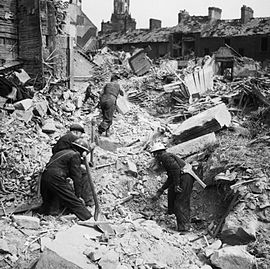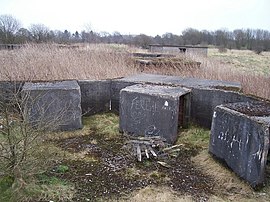The 38th Light Anti-Aircraft Brigade was an air defence formation of Britain's Territorial Army formed just before the Second World War, which protected London and Southern England during the Blitz and later converted into an infantry formation for the liberation of Europe.

The 2nd Anti-Aircraft Division was an Air Defence formation of the British Army from 1935 to 1942. It controlled anti-aircraft gun and searchlight units of the Territorial Army (TA) defending the East Midlands and East Anglia during The Blitz.
The 40th Anti-Aircraft Brigade was an air defence formation of Anti-Aircraft Command in the British Territorial Army (TA) formed shortly before the outbreak of the Second World War. Its initial role was to defend Royal Air Force (RAF) airfields in East Anglia. Later it commanded part of the searchlight belt protecting The Midlands. In 1944 the brigade was moved south to protect the embarkation ports for Operation Overlord and to defend against V-1 flying bombs in Operation Diver. It was briefly reformed in the postwar TA.
The 34th Anti-Aircraft Brigade was an air defence formation of Anti-Aircraft Command in the British Territorial Army formed shortly before the outbreak of the Second World War. It defended the West Midlands of England during The Blitz.
35th Anti-Aircraft Brigade was an air defence formation of Anti-Aircraft Command in the British Territorial Army (TA) formed shortly before the outbreak of the Second World War. It defended the important naval base of Portsmouth during The Blitz.

The 3rd Anti-Aircraft Division was an air defence formation of the Territorial Army, part of the British Army, created in the period of tension before the outbreak of the Second World War. It defended Scotland and Northern Ireland during the early part of the war.
The 41st (London) Anti-Aircraft Brigade was an air defence formation of Anti-Aircraft Command in the British Territorial Army, formed shortly before the outbreak of the Second World War. Its role was to defend East Anglia.
36th (Scottish) Anti-Aircraft Brigade was an air defence formation of Britain's Territorial Army, created in the period of tension before the outbreak of the Second World War. It was responsible for defending eastern Scotland.

The 4th Anti-Aircraft Division was an air defence formation of Britain's Territorial Army, created in the period of tension before the outbreak of the Second World War. It defended North West England during the Blitz.
39th Anti-Aircraft Brigade was an air defence formation of Britain's Territorial Army (TA) during the Second World War. It was responsible under Anti-Aircraft Command for protecting industry along the Humber Estuary and airfields in Lincolnshire during The Blitz. Later it defended the coast of East Anglia against Luftwaffe 'hit-and-run' attacks. It was later converted to a field force formation, covered the embarkation ports for Operation Overlord and defended London against V-1 flying bombs. It served in the campaign in North West Europe, defending Antwerp against V-1s and supervising the clean-up of the notorious Bergen-Belsen concentration camp.
43rd Anti-Aircraft Brigade was an air defence formation of Britain's Territorial Army (TA). Formed in 1938, it was responsible for protecting Teesside in North East England during the early part of the Second World War, and later defended South East England from V-1 flying bombs. It was reformed postwar and survived under different titles until 1961.

The 7th Anti-Aircraft Division was an air defence formation of the British Army during the early years of the Second World War. It defended North East England during the Battle of Britain and The Blitz.

The 8th Anti-Aircraft Division was an air defence formation of the British Army during the early years of the Second World War. It defended South West England during The Blitz and the Luftwaffe 'hit and run' raids, but only had a short career.

The 9th Anti-Aircraft Division was an air defence formation of the British Army during the middle years of the Second World War. It defended South Wales and the Severn Valley during The Blitz but only had a short career.

The 10th Anti-Aircraft Division was an air defence formation of the British Army during the early years of the Second World War. It defended Yorkshire and Northern Lincolnshire during The Blitz and the Baedeker Blitz but only had a short career.

The 11th Anti-Aircraft Division was an air defence formation of the British Army during the early years of the Second World War. It defended the West Midlands during The Blitz, including the notorious raid on Coventry, and the subsequent Baedeker Blitz, but only had a short career.
6th Anti-Aircraft Brigade was an air defence formation of the British Army formed during the Second World War. It served in the disastrous Norwegian Campaign in 1940 and then defended East Anglia during the Battle of Britain and The Blitz. It was reorganised to take part in the invasion of Normandy, but instead was diverted to defending Southern England against V-1 flying bombs. It was briefly recreated in the postwar Regular Army.
44th Anti-Aircraft Brigade was an air defence formation of Britain's Territorial Army (TA). Formed in 1938, it was responsible for protecting Manchester and later the Isle of Wight during the Second World War. It was reformed postwar under a new title, and continued until 1955.
3rd Anti-Aircraft Brigade was a Supplementary Reserve air defence formation of the British Army formed in Northern Ireland in 1938. On the outbreak of the Second World War it saw active service with the British Expeditionary Force during the Battle of France and Operation Aerial. It then returned to Northern Ireland and defended the Province for the next two years. Postwar, it was reformed in the Territorial Army and served until the disbandment of Anti-Aircraft Command in 1955.
45th Anti-Aircraft Brigade was an air defence formation of Britain's Territorial Army (TA). Formed in 1938, it was responsible for protecting South Wales during the Second World War. It was reformed in the postwar TA under a new title, and continued until 1955.











